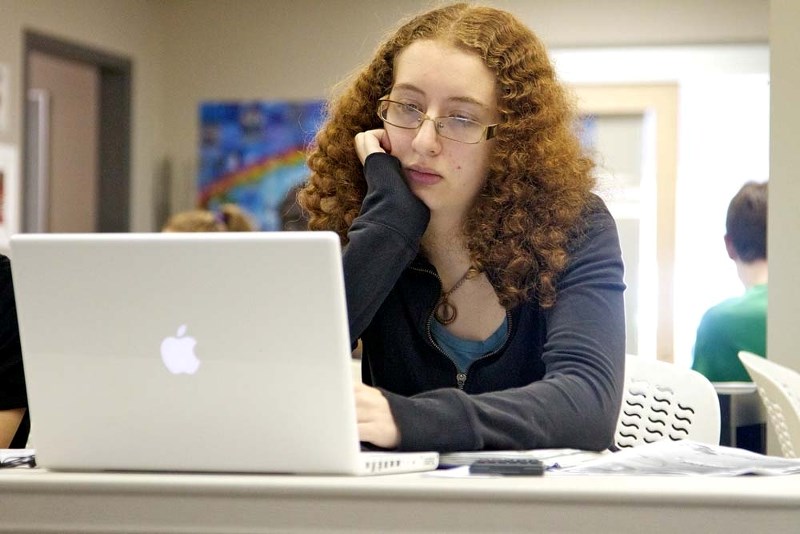Should St. Albert's Catholic high schools form a super-campus? How about an elite academy? Are they working fine the way they are now?
Those are the kinds of questions city residents will get to answer this month as part of a survey by Greater St. Albert Catholic Schools on the future of the board's high schools.
About 12 residents came to St. Albert Catholic High School (SACHS) Wednesday night for a focus group as part of the Shaping Our Future study – a survey that asks residents to set the future course of the division's high schools.
The board holds talks like this each year on various topics, said superintendent David Keohane. Since this year's topic is so broad, however, it's doing a larger consultation with multiple focus groups and an online survey. (Similar talks were held in Morinville earlier this year.)
"This is a big, big conversation, and we want to make sure we do it right," he said. "It's open to parents, community members, staff and students."
This topic was originally prompted by a question from a parent, but resonates with the province's push under Inspiring Education to rework schools to meet future student needs, Keohane said.
It also reflects an ongoing issue of students who jump ship from école Secondaire Sainte Marguerite d'Youville (ESSMY) to other high schools when they enter Grade 10, he continued. While many students like the all-French ESSMY, some students end up leaving it for places like SACHS or Paul Kane as they offer better options and sports programs.
Considering their options
The board researched other schools in Alberta and came up with three possible paths for the future.
The first would be a status-quo approach that would focus on the board's strengths and likely add a French immersion option at SACHS.
Nicole S. was one of several parents in the focus group concerned that this could mean an end to single-track French education at ESSMY. The total immersion students get at ESSMY greatly boosts their ability to speak French, she said.
Deb, another parent, agreed, noting that she had heard many criticisms of dual-track approaches.
"I think (the French) is a little too diluted," she said.
Keohane later clarified that single-track French immersion at ESSMY isn't going away.
"I can tell you with absolute certainty that there are no plans to change what's happening at ESSMY," he said.
Still, a dual-track option could let more students stick with French and get more options without jumping to Paul Kane, said SACHS principal Garret Doll.
Path two proposes to combine ESSMY and SACHS into one super-campus – the idea being that with their combined populations, the schools could offer more programs to more students.
Keohane likened it to how the Faculté Saint-Jean works with the University of Alberta, where students would flip between schools to take different courses. This would let ESSMY students get the career, technology and sports options offered at SACHS without giving up French immersion. Students might shuttle between the schools during the day, or flip between schools each semester.
This could be a logistical nightmare, Deb said.
"We're going to need an LRT to get to all these different options," she joked.
Path three proposes more of a prep-school or private academy approach. Emphasizing flexible schedules and self-directed learning, this approach would focus on student leadership, international exchanges and academy-style training for elite students.
There would be plenty of dual-credit courses and partnerships with businesses, all aimed to equip students for university or a job upon graduation.
This approach would emphasize career-relevant skills, particularly soft skills such as teamwork, communication and initiative – skills employers and post-secondary instructors say today's high school grads often don't have, Keohane said.
An approach like this could help students better connect what they do in school to their lives as adults, Doll said. High schools are already starting down this road by offering dual-credit courses through Grant MacEwan University.
Flexible scheduling could help more students graduate, noted parent Mary Pat Langhenry.
"We have an awesome graduation rate of 88 per cent. I'd love to capture that other 12 per cent," she said.
Other parents were concerned that less-dedicated students might struggle with flexible schedules.
Long-term plan
Keohane hopes residents will fill out the board's online survey or come to the next focus group at the Kinsmen Korral from 9:30 a.m. to noon this March 5.
"This is careful planning we're doing for the future," he emphasized, so don't expect any major changes soon. "We don't want to take a big, bold step without people following us."
Keohane said the Catholic board will get a report on the survey's results this summer, with the ideas presented used to plan out high school programming in the next five to 10 years.
Visit gsacrd.ab.ca for details on the survey.




